Epidendrum orchid
Last reviewed: 29.06.2025
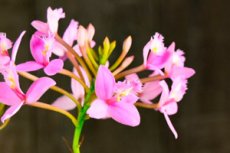
The Epidendrum orchid ( Epidendrum) is a large genus in the Orchidaceae family, encompassing over 1,500 species. These orchids are widely distributed across tropical and subtropical regions of the Americas. Known for their ornamental value and hardiness, they are a popular choice for both amateur gardeners and professional collectors. Epidendrum flowers are characterized by their vibrant colors and diverse shapes, with many species capable of blooming year-round under favorable conditions.
Etymology of the name
The genus name Epidendrum is derived from the Greek words "epi" (on) and "dendron" (tree), referencing the epiphytic nature of many species. The name was first proposed by Carl Linnaeus in 1763 to describe orchids that grow on trees.
Life form
Epidendrum orchids are primarily epiphytic, meaning they grow on trees and use them as structural support. However, some species exhibit lithophytic (rock-dwelling) or terrestrial habits, adapting to a variety of environmental conditions.
These orchids are well-adapted to survive in fluctuating environments. Their aerial roots are covered with velamen, which efficiently absorbs moisture and protects the roots from drying out, a critical adaptation for periods of drought.
Family
Epidendrum belongs to the Orchidaceae family, one of the largest families of flowering plants. The family comprises around 28,000 species, distinguished by their diverse forms and ecological adaptations.
A key feature of this family is the complex structure of their flowers, evolved to attract specific pollinators. Epidendrum flowers often have specialized structures, such as a lip, designed to guide pollinators.
Botanical characteristics
Epidendrum orchids are perennial plants, with or without pseudobulbs. The leaves are linear or lanceolate, leathery, and arranged on upright or creeping stems. The flowers, often in bright shades of pink, red, orange, or green, are grouped in racemes or panicles. Flower diameters range from 2 to 8 cm.
The aerial roots are covered in velamen, which not only absorbs moisture but also participates in photosynthesis. This makes Epidendrum orchids resilient to short periods of drought.
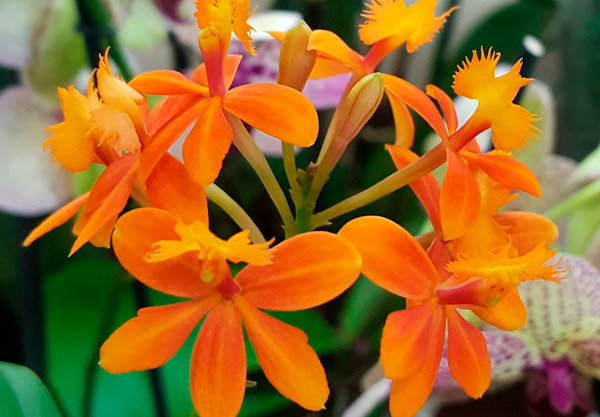
Chemical composition
The chemical composition of Epidendrum orchids includes flavonoids, alkaloids, and terpene compounds that protect the plant from pathogens and insect pests. The flowers' vibrant colors are due to anthocyanins.
Origin
The genus Epidendrum originates from the tropical and subtropical regions of the Americas, extending from the southern United States to Argentina. The highest species diversity is found in Central and South America, particularly in the mountainous areas of the Andes.
Their natural habitats include humid tropical forests, dry forests, and high-altitude regions. These orchids are highly adaptable to different climates, making them popular in ornamental horticulture.
Ease of cultivation
Epidendrum orchids are considered easy to grow, making them suitable for novice gardeners. They can adapt to a wide range of temperatures and light conditions.
The plant tolerates occasional care mistakes, such as irregular watering or temporary drops in air humidity. However, proper lighting and nutrition are essential for abundant flowering.
Species and varieties
Popular species of Epidendrum include Epidendrum radicans,
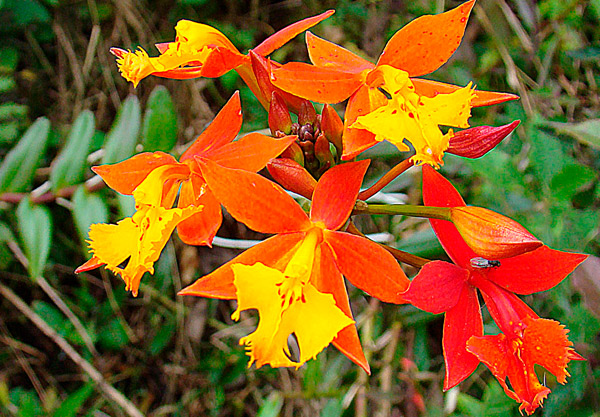
Epidendrum nocturnum, and
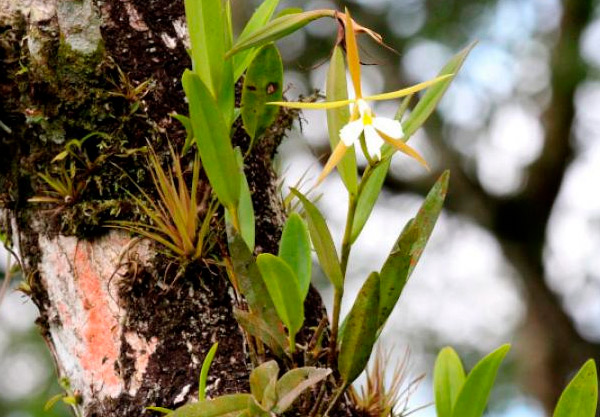
Epidendrum ibaguense.
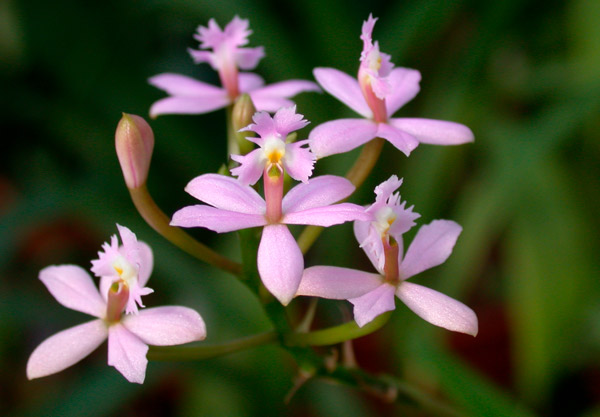
Hybrids such as Epidendrum Candy Dancer and Epidendrum Green Hornet are noted for their larger flowers and bright colors.
Size
The size of Epidendrum orchids varies depending on the species. Miniature varieties may reach heights of 20–30 cm, while larger species, such as Epidendrum radicans, can grow up to 1.5 meters.
Flower spikes can reach lengths of 50–60 cm, making the plant a striking centerpiece in interiors or gardens. Despite their relatively small flower size, Epidendrum flowers are vibrant and eye-catching.
Growth rate
Epidendrum orchids have a moderate growth rate. Each year, the plant typically produces 1–2 new shoots, which later develop into flowering stems.
Growth accelerates under sufficient lighting and regular feeding. However, over-fertilizing should be avoided, as it may lead to salt buildup in the substrate.
Lifespan
With proper care, Epidendrum orchids can live for decades, producing blooms annually. Older stems remain green and functional for several years.
In natural habitats, the lifespan may be shortened due to competition and environmental stressors. However, in cultivation, they demonstrate remarkable longevity.
Temperature
Epidendrum orchids thrive in moderate temperatures ranging from 18–25 °C. They can tolerate brief temperature increases up to 30 °C if humidity levels are maintained.
Nighttime temperature drops (5–7 °C lower than daytime temperatures) stimulate flowering, especially in mountainous species.
Humidity
The plant requires air humidity levels of 50–70%. In drier conditions, using humidifiers or water trays is recommended.
Excess moisture can lead to root rot, so good ventilation is crucial to maintaining healthy growth.
Lighting and placement in a room
Epidendrum orchids need bright, diffused light. East- or west-facing windows are ideal. Direct sunlight is suitable during morning or evening hours, but midday light requires shading.
To ensure even growth, rotate the pot periodically relative to the light source. If natural light is insufficient, supplemental grow lights can be used.
Soil and substrate
For successful cultivation, Epidendrum orchids require a substrate that ensures optimal aeration and drainage. The ideal mix includes:
- Coarse pine bark (50%);
- Sphagnum moss (20%);
- Perlite or small pumice stones (15%);
- Charcoal (10%);
- Coarse sand (5%).
The recommended substrate pH is 5.5–6.5, providing a slightly acidic environment. Place a 2–3 cm layer of drainage material, such as expanded clay or gravel, at the bottom of the pot to prevent waterlogging.
Watering
In summer, Epidendrum requires regular and abundant watering. Submerge the roots entirely in soft water for 10–15 minutes, then allow excess water to drain. Water every 5–7 days, depending on temperature and humidity levels.
In winter, reduce watering frequency to once every 10–14 days. Use room-temperature, dechlorinated water. Allow the substrate to partially dry out between waterings to avoid root rot.
Fertilization and feeding
Water-soluble fertilizers with a low nitrogen concentration are ideal for Epidendrum orchids. Fertilizers high in phosphorus and potassium are preferable as they promote flowering and strengthen the root system.
Fertilizers should be diluted in water at a concentration of 1/4 the recommended dose and applied during watering. Feed the plant every two weeks during active growth, reducing to once a month in winter.
Propagation
The best time to propagate Epidendrum is in spring when the plant begins active growth. Propagation can also be done in early summer before the flowering period.
The primary propagation methods include dividing mature plants and rooting young shoots. Seed propagation is less common, as it requires sterile conditions and the presence of symbiotic fungi for germination.
Flowering
Epidendrum orchids can bloom year-round under favorable conditions. The flowers last for 4–6 weeks, with up to 20 blooms per spike.
After flowering, flower spikes should only be removed if no new buds appear. This conserves the plant's energy for future growth.
Seasonal features
During spring and summer, Epidendrum experiences active growth and flowering. The plant requires abundant watering and regular feeding. High air humidity and good ventilation are crucial during this period.
In autumn, gradually reduce watering, and decrease feeding frequency. During winter dormancy, the plant needs minimal care and cooler temperatures.
Care specifics
Epidendrum requires stable air humidity levels of 50–70%. Use a humidifier or place the pot on a tray with water to maintain adequate moisture. However, ensure the roots do not touch the water.
Regular ventilation is necessary to prevent diseases, but avoid drafts that may damage leaves and flowers.
Indoor care
Epidendrum orchids need bright, diffused light. East- or west-facing windows are ideal. In south-facing rooms, shade the plant during midday to prevent sunburn.
Transparent pots are recommended for monitoring root health. When grown on mounts, frequent misting of the roots is essential.
Repotting
For repotting, select plastic or ceramic pots with drainage holes. The pot size should accommodate the root system, leaving space for growth.
Repotting is necessary every 2–3 years or when the substrate begins to break down. Spring is the best time to repot, just before active growth begins.
Pruning and shaping
Prune Epidendrum after flowering by removing spent flower spikes and damaged leaves. This encourages rejuvenation and promotes the growth of new shoots.
Remove old or dried roots to enhance the plant's health and maintain its decorative appearance.
Common problems and solutions
Root and leaf rot are common issues caused by overwatering. Prevention includes proper watering and using a well-draining substrate.
Insufficient light leads to elongated shoots and lack of flowering. Yellowing leaves may indicate overwatering or sunburn.
Pests
Epidendrum orchids can be affected by spider mites, thrips, and scale insects. These pests damage leaves and roots, slowing plant growth.
Regularly mist leaves and roots with water to prevent infestations. Use insecticides, such as pyrethroid-based products, for pest control if necessary.
Air purification
Epidendrum helps purify indoor air by removing harmful substances such as formaldehyde and benzene. This makes it a valuable addition to urban interiors.
Safety
Epidendrum is non-toxic and safe for children and pets. However, individual allergic reactions to its pollen or sap may occur.
Winter care
In winter, reduce watering to once every 10–14 days and lower temperatures to 16–18 °C. These conditions prepare the plant for spring growth and flowering.
Beneficial properties
Beyond its decorative appeal, Epidendrum improves indoor air quality by increasing humidity and reducing airborne pollutants.
Use in traditional medicine
While Epidendrum is not widely used in traditional medicine, it is occasionally incorporated into aesthetic arrangements with medicinal plants.
Use in landscape design
Epidendrum is ideal for decorating vertical gardens and hanging arrangements. Its vibrant flowers create eye-catching accents, perfect for terraces and balconies.
Compatibility with other plants
Epidendrum pairs well with other epiphytic orchids, such as Phalaenopsis and Oncidiums. Their combined cultivation allows for creating multi-layered compositions.
Conclusion
Epidendrum is a versatile orchid that combines ornamental beauty, ease of care, and ecological benefits. With proper care, it will become a stunning addition to any home or garden, delighting its owner for years to come.
